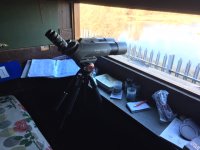Having now happily settled on Nikon 8x30E2 after much forum input, I wondered how I could continue to enjoy the wide 2-eyed views that we all like here but with the higher power I get with my spotting scope.
I looked at the option of binoviewers (require too much focus in travel, as they split the light in half so dimmer views) and then looked at Astro binoculars (fixed eyepieces, imperfect narrower views and limited power). I finally came across the new APM 70mm 45degree eyepiece binoculars. These are triplet ED apochromatic and take widely available astro 1.25” eyepieces, so plenty of good choices. I believe these are nitrogen purged for those who need it. They’re made from Magnesium, so their size and weight would make them fit my lightweight backpack for easy carrying and would not overload the manfrotto tripod I use with my spotter. With a pair of eyepieces in they are 4.5kg, bit of sliding the clamp plate on my tripod head to keep the balance depending on where they are pointing.
The supplied 18mm eyepieces (22x) provide a nice 65degree field of view, distortion free, sharp practically to the edge and with any chromatic aberration only hinted at at the very edges. I also used some ultra wide Astro 13mm eyepieces, 30x and so a bit dimmer, but with a wider apparent field still, but some slight distortion and a narrower depth of focus.
The eye separation distance adjustment is stiff and once set stays put. It has individual eye focussing, which was a first for me, but isn’t too hard to tweak. You do each eye separately and then if you rotate both together, it’s nearly the same as centre focus. There is a notch in the carry handle that is easy to sight along, so finding stuff isn’t too hard and the wide fields give context to the view.
I took them to my local Ramsar wetland site, which has recently been flooded as part of management. From the usual hide the birds are 1-400m away, so normal binoculars are of limited use.
The apparent field of view with the 18mm is slightly less than the 8x30E2, but they had a much better view closer towards the edges. The 8x Nikon seemed disappointing after using the larger bins.
I found a number of birds I would never have spotted with the 8x and spent a long time watching them go about their business. I especially like the snipe and lapwing, both hiding in the vista ahead of me.
Neither fish nor fowl. Binoculars that need a tripod or a rather heavy (2eyed) spotting scope. The size and quality of the field of view mean these are definitely going to be seeing a lot of use when I am observing from hides.
Peter
I looked at the option of binoviewers (require too much focus in travel, as they split the light in half so dimmer views) and then looked at Astro binoculars (fixed eyepieces, imperfect narrower views and limited power). I finally came across the new APM 70mm 45degree eyepiece binoculars. These are triplet ED apochromatic and take widely available astro 1.25” eyepieces, so plenty of good choices. I believe these are nitrogen purged for those who need it. They’re made from Magnesium, so their size and weight would make them fit my lightweight backpack for easy carrying and would not overload the manfrotto tripod I use with my spotter. With a pair of eyepieces in they are 4.5kg, bit of sliding the clamp plate on my tripod head to keep the balance depending on where they are pointing.
The supplied 18mm eyepieces (22x) provide a nice 65degree field of view, distortion free, sharp practically to the edge and with any chromatic aberration only hinted at at the very edges. I also used some ultra wide Astro 13mm eyepieces, 30x and so a bit dimmer, but with a wider apparent field still, but some slight distortion and a narrower depth of focus.
The eye separation distance adjustment is stiff and once set stays put. It has individual eye focussing, which was a first for me, but isn’t too hard to tweak. You do each eye separately and then if you rotate both together, it’s nearly the same as centre focus. There is a notch in the carry handle that is easy to sight along, so finding stuff isn’t too hard and the wide fields give context to the view.
I took them to my local Ramsar wetland site, which has recently been flooded as part of management. From the usual hide the birds are 1-400m away, so normal binoculars are of limited use.
The apparent field of view with the 18mm is slightly less than the 8x30E2, but they had a much better view closer towards the edges. The 8x Nikon seemed disappointing after using the larger bins.
I found a number of birds I would never have spotted with the 8x and spent a long time watching them go about their business. I especially like the snipe and lapwing, both hiding in the vista ahead of me.
Neither fish nor fowl. Binoculars that need a tripod or a rather heavy (2eyed) spotting scope. The size and quality of the field of view mean these are definitely going to be seeing a lot of use when I am observing from hides.
Peter






